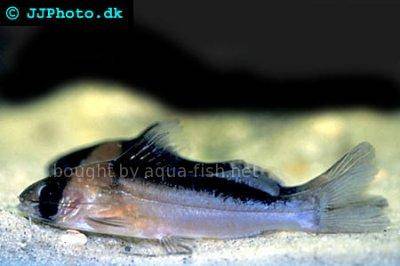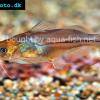False adolfoi - Brachyrhamdia rambarrani
Scientific name: Brachyrhamdia rambarrani
Common name: False adolfoi
Family: Heptapteridae
Usual size in fish tanks: 6 - 7 cm (2.36 - 2.76 inch)
014
Recommended pH range: 6.1 - 7
Recommended water hardness: 10 - 21°N (178.57 - 375ppm)
0°C 32°F30°C 86°F
Recommended temperature range: 23 - 26 °C (73.4 - 78.8°F)
The way how these fish reproduce: Spawning
Where the species comes from: South America
Temperament to its own species: peaceful
Temperament toward other fish species: peaceful
Usual place in the tank: Bottom levels
Food and Feeding
False Adolfoi catfish are not picky eaters and will accept a wide variety of foods. However, it's important to avoid overfeeding to maintain optimal health and water quality. For their staple diet, provide high-quality sinking pellets and algae wafers, which ensure that food reaches the lower levels of the tank where these fish primarily feed. Twice a week, offer protein-rich treats like bloodworms and brine shrimp to help maintain their vibrant coloration and overall health. The variety in diet is essential to meet their nutritional needs and mimic their natural feeding habits in the wild.
Origin
The False Adolfoi catfish, or Brachyrhamdia rambarrani, originates from the Rio Negro in Brazil, a well-known blackwater river system in South America. These waters are typically soft, acidic, and rich in organic matter, which gives them a tea-like color due to decaying vegetation. In their natural habitat, they inhabit areas with sandy or muddy substrates and abundant plant debris, where they forage for small invertebrates and organic matter. Replicating these water conditions and substrate types in the aquarium will help these fish feel more at home.
Sexing
Sexing False Adolfoi catfish can be challenging, especially when they are young. As they mature, females tend to be slightly larger and have a stockier, fuller body shape, particularly around the abdomen. This size difference is most noticeable when viewed from above. Males, in comparison, are typically slimmer and more streamlined.
Breeding
While False Adolfoi catfish have not yet been successfully bred in captivity, they are believed to follow the breeding patterns of other Corydoras species. In the wild, they are egg scatterers, meaning they release their eggs across the substrate without providing parental care. For those looking to attempt breeding, providing soft, acidic water conditions and a well-maintained tank with plenty of hiding spots may encourage breeding behavior, though success in home aquariums has yet to be documented.
Lifespan
With proper care, the False Adolfoi catfish can live between 3 to 5 years in captivity. Maintaining clean water conditions, a balanced diet, and a stable environment will help ensure they reach their full lifespan. Regular water changes and monitoring of water parameters are essential to their long-term health.
Short Description
False Adolfoi catfish are peaceful, social fish that should always be kept in groups of at least five or more to reduce stress and encourage natural behavior. These fish are bottom-dwellers, so providing a substrate of fine sand or smooth gravel is crucial to protect their sensitive barbels from damage. Adding plenty of hiding places, such as driftwood, plants, and caves, will give them the security they need, especially as they are more active during the evening and nighttime hours. Like many Corydoras, Brachyrhamdia rambarrani thrive in tanks with low to moderate lighting and a well-oxygenated, slightly acidic water environment.
Pictures
Bought by aqua-fish.net from jjphoto.dk.




 Mees’
Mees’